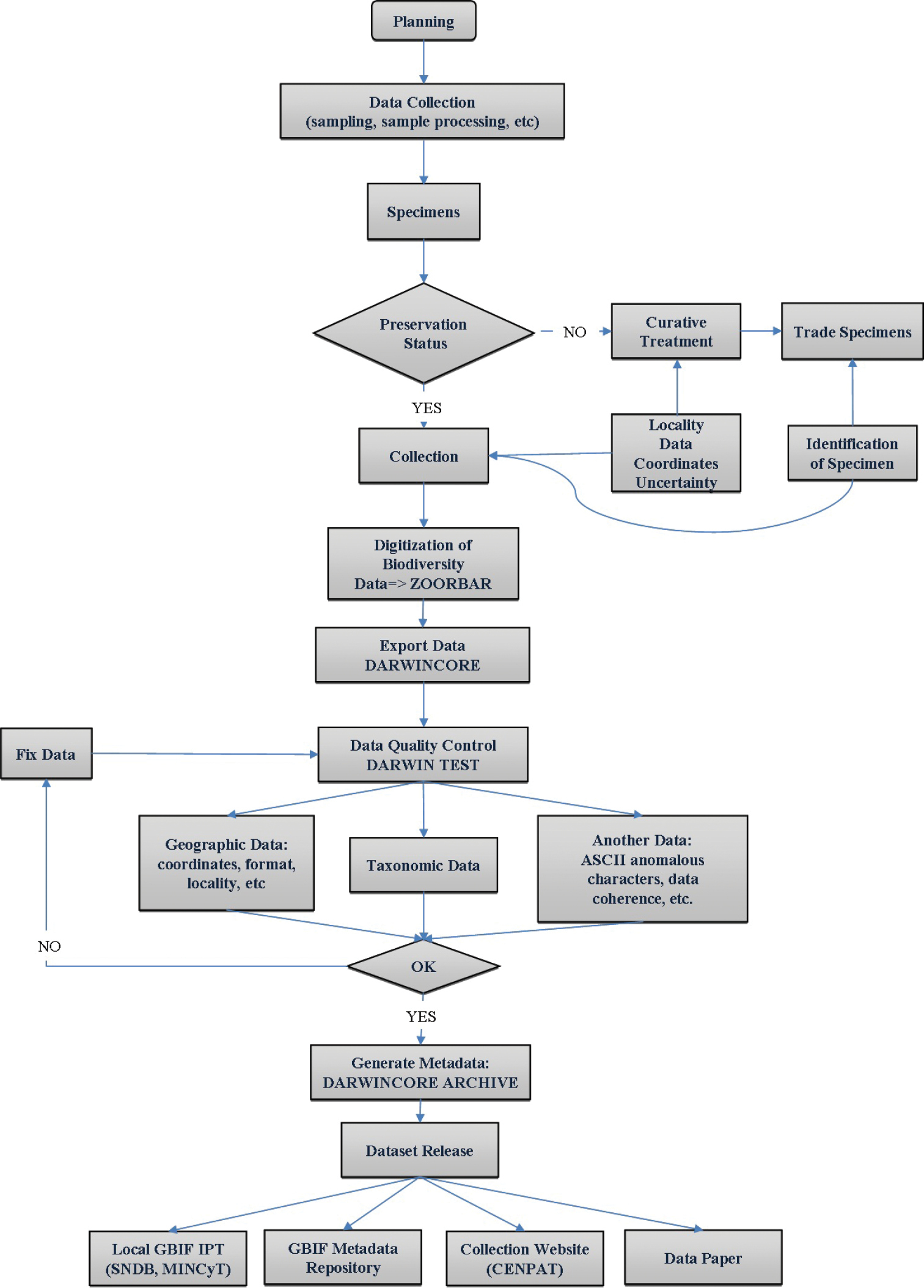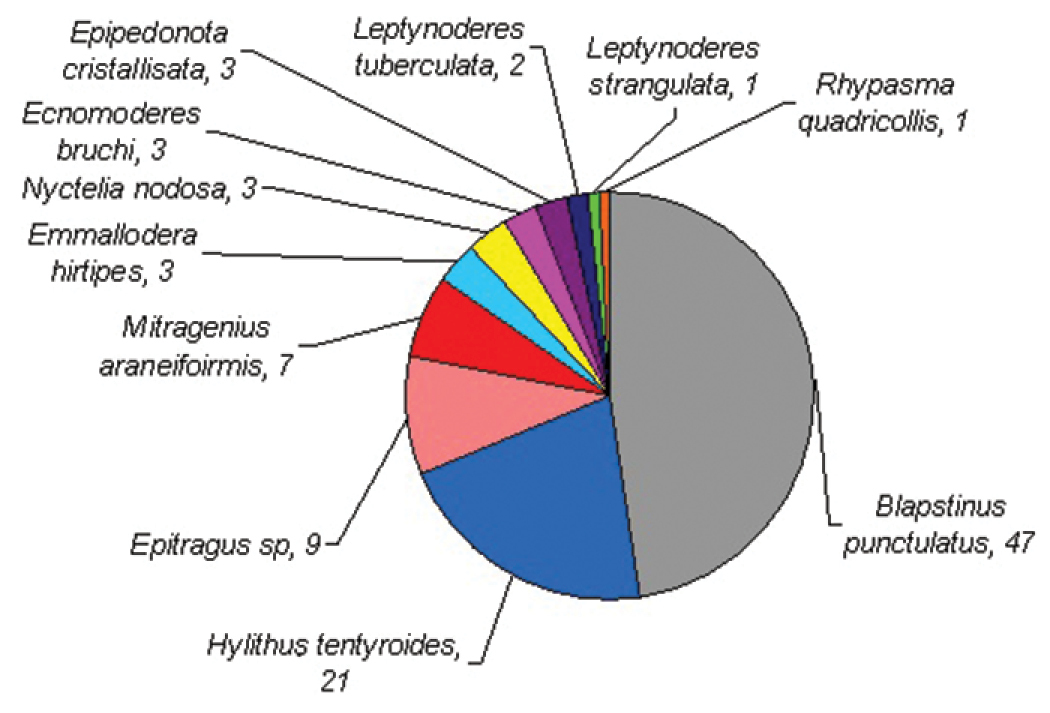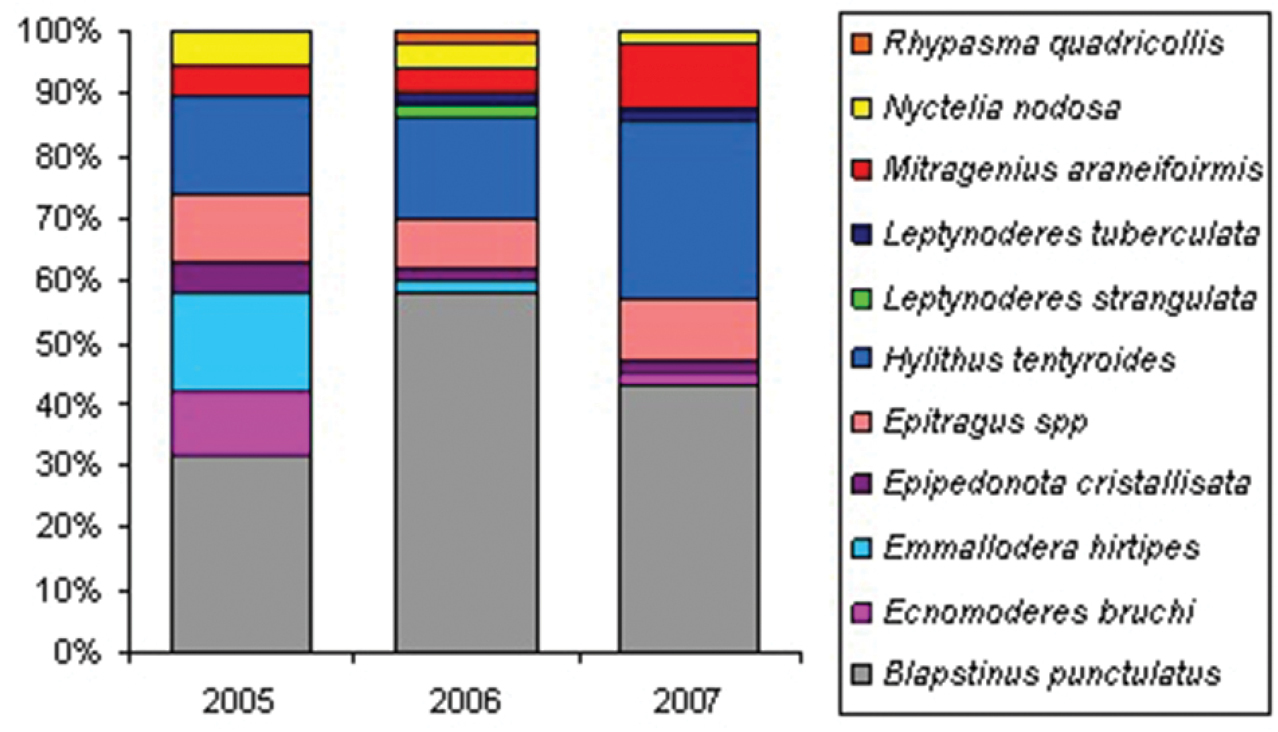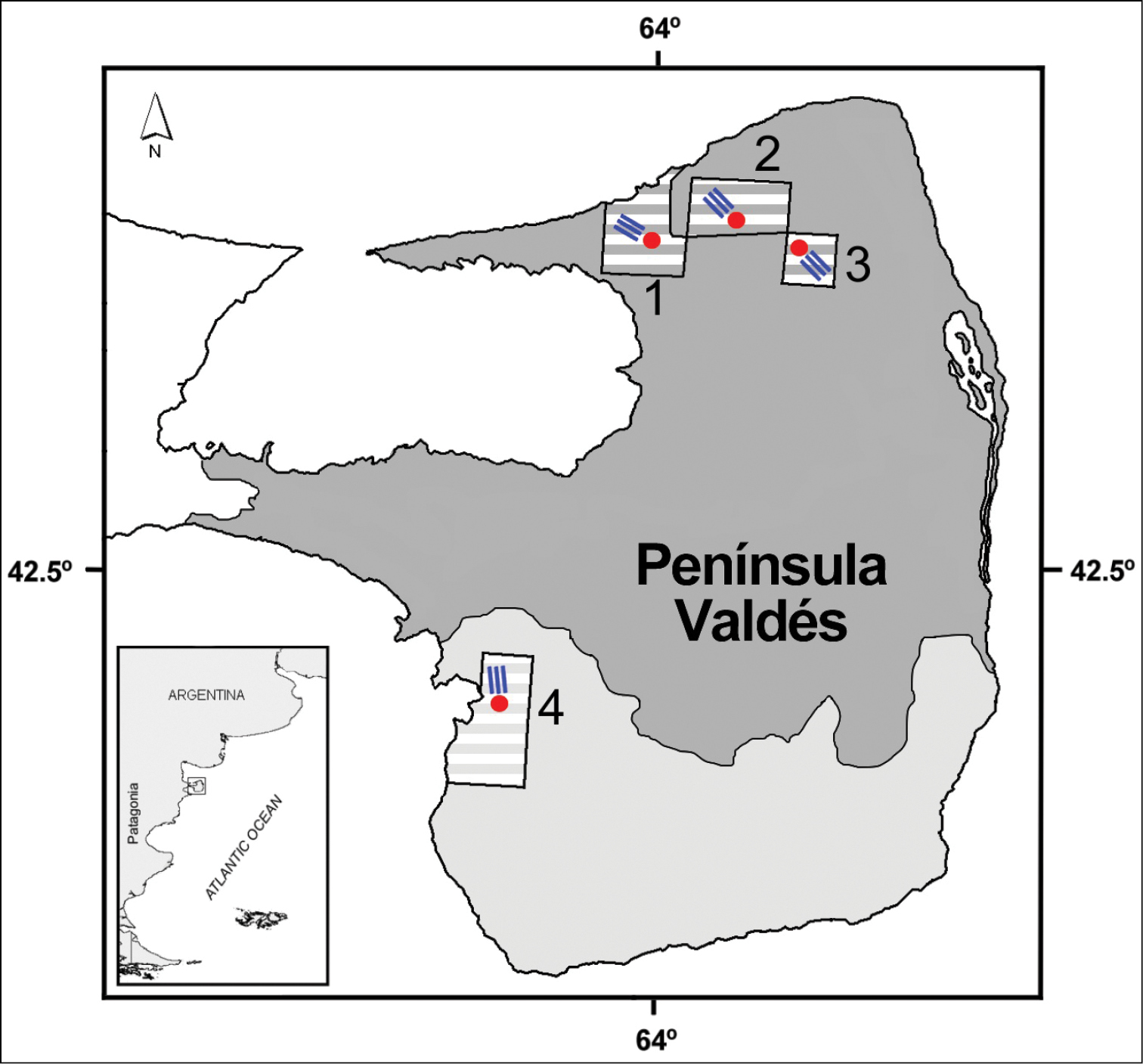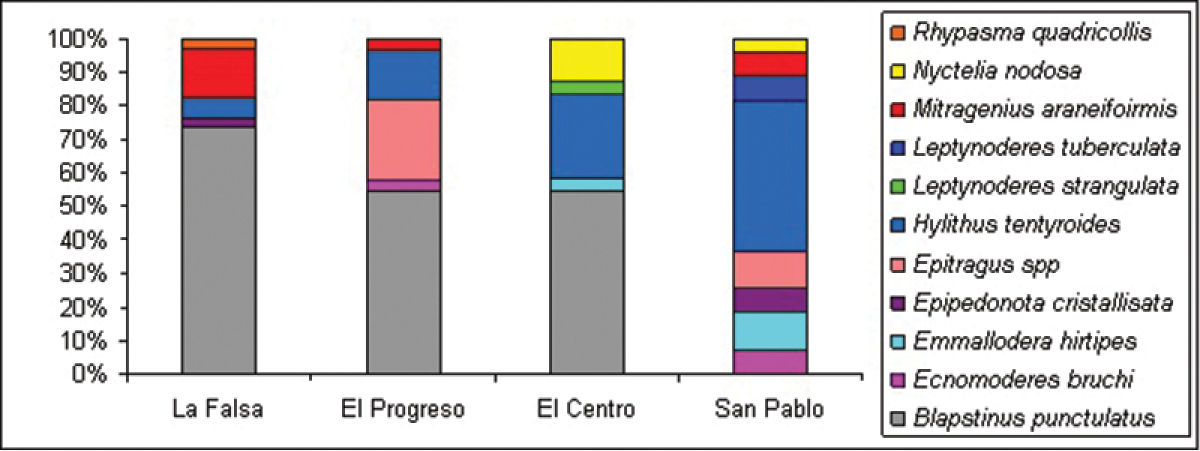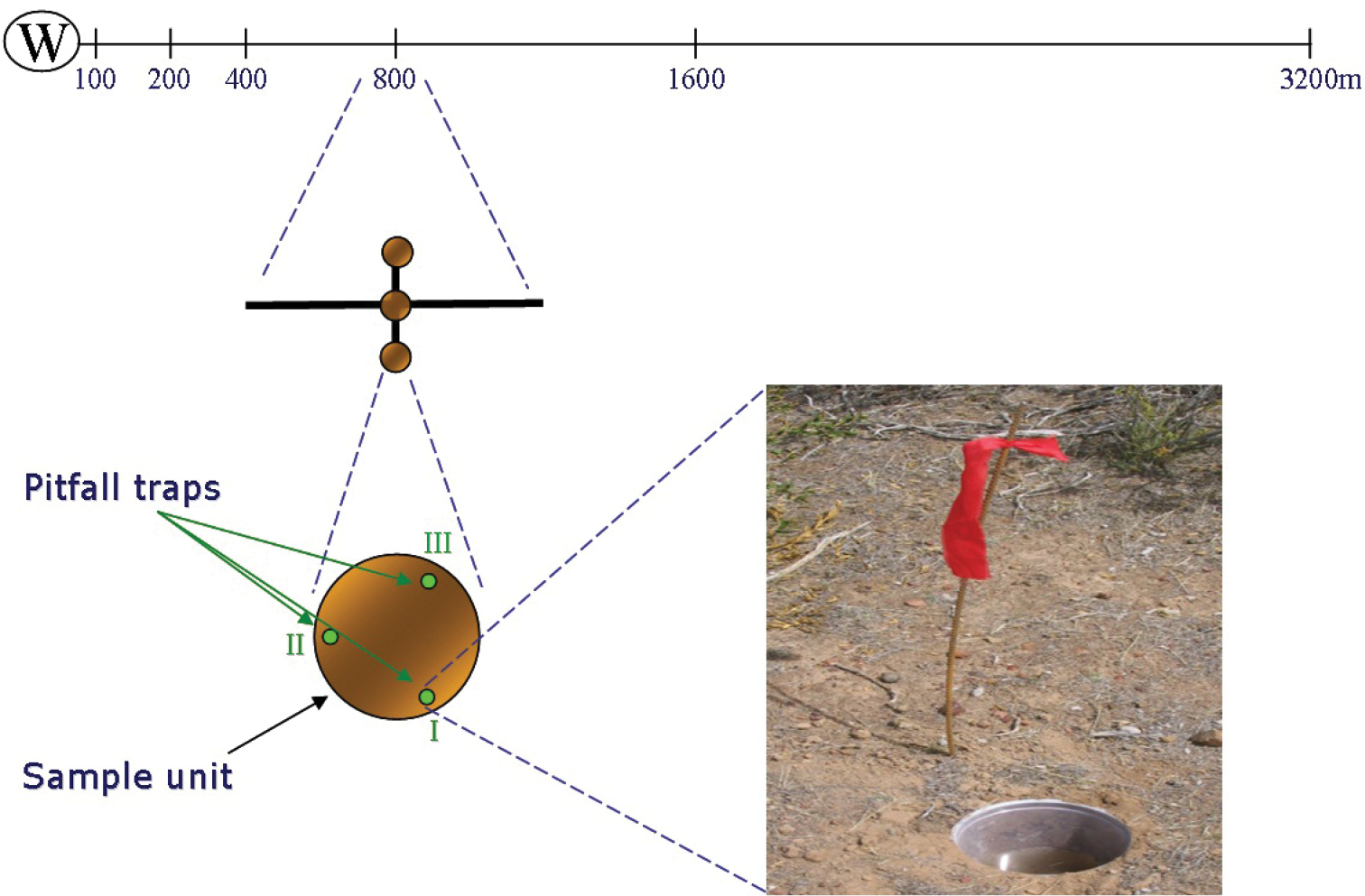






(C) 2013 Germán H. Cheli. This is an open access article distributed under the terms of the Creative Commons Attribution License (CC BY 4.0), which permits unrestricted use, distribution, and reproduction in any medium, provided the original author and source are credited.
For reference, use of the paginated PDF or printed version of this article is recommended.
Citation: Cheli GH, Flores GE, Martínez Román N, Podestá D, Mazzanti R, Miyashiro L (2013) A Tenebrionid beetle’s dataset (Coleoptera, Tenebrionidae) from Peninsula Valdés (Chubut, Argentina). ZooKeys 364: 93–108. doi: 10.3897/zookeys.364.4761 GBIF Key: http://www.gbif.org/dataset/0549aec6-5e7b-46a8-af80-76a3712c0ef6
Resource citation: Centro Nacional Patagónico (CENPAT) (2013), A Tenebrionid beetle’s dataset (Coleoptera, Tenebrionidae) from Peninsula Valdés (Chubut, Argentina), 118 records, Contributed by Cheli GH, Flores GE, Martínez Román N, Podestá D, Mazzanti R and Miyashido L. Available online at http://data.gbif.org/datasets/resource/14669/ and http://datos.sndb.mincyt.gob.ar/portal/datasets/resource/162, Version 9 (last updated on 2013-09-17), Resource ID: GBIF Key: http://www.gbif.org/dataset/0549aec6-5e7b-46a8-af80-76a3712c0ef6, Data Paper ID: doi: 10.3897/zookeys.364.4761
The Natural Protected Area Peninsula Valdés, located in Northeastern Patagonia, is one of the largest conservation units of arid lands in Argentina. Although this area has been in the UNESCO World Heritage List since 1999, it has been continually exposed to sheep grazing and cattle farming for more than a century which have had a negative impact on the local environment. Our aim is to describe the first dataset of tenebrionid beetle species living in Peninsula Valdés and their relationship to sheep grazing. The dataset contains 118 records on 11 species and 198 adult individuals collected. Beetles were collected using pitfall traps in the two major environmental units of Peninsula Valdés, taking into account grazing intensities over a three year time frame from 2005–2007. The Data quality was enhanced following the best practices suggested in the literature during the digitalization and geo-referencing processes. Moreover, identification of specimens and current accurate spelling of scientific names were reviewed. Finally, post-validation processes using DarwinTest software were applied. Specimens have been deposited at Entomological Collection of the Centro Nacional Patagónico (CENPAT-CONICET). The dataset is part of the database of this collection and has been published on the internet through GBIF Integrated Publishing Toolkit (IPT) (http://data.gbif.org/datasets/resource/14669/). Furthermore, it is the first dataset for tenebrionid beetles of arid Patagonia available in GBIF database, and it is the first one based on a previously designed and standardized sampling to assess the interaction between these beetles and grazing in the area. The main purposes of this dataset are to ensure accessibility to data associated with Tenebrionidae specimens from Peninsula Valdés (Chubut, Argentina), also to contribute to GBIF with primary data about Patagonian tenebrionids and finally, to promote the Entomological Collection of Centro Nacional Patagónico (CENPAT-CONICET) and its associated biodiversity data. For these reasons, we believe that this information will certainly be useful for future faunistic, ecological, conservational and biogeographical studies.
Patagonia, Peninsula Valdés, Tenebrionidae, Pimeliinae, Tenebrioninae, Lagriinae, Edrotini, Nycteliini, Epitragini, Stenosini, Scotobiini, Opatrini, Belopini, Blapstinus punctulatus, Ecnomoderes bruchi, Emmallodera hirtipes, Epipedonota cristallisata, Hylithus tentyroides, Leptynoderes strangulata, Leptynoderes tuberculata, Mitragenius araneiformis, Nyctelia nodosa, Rhypasma quadricollis, Epitragus spp.
Purpose: The general purpose of this dataset is to ensure accessibility to data associated with Tenebrionidae specimens from Peninsula Valdés (Chubut, Argentina) deposited in the Entomological Collection of Centro Nacional Patagónico (CENPAT-CONICET), Argentina. At present, datasets about Tenebrionidae beetles in GBIF portal contains only two records of Tenebrionids for whole Patagonia (accessed 04/13/2013), one of these is a fossil record, interpreted as Tenebrionidae indet (Locality: Rio Pichileufu, Rio Negro; Data Publisher: Marine Science Institute, UCSB; Dataset: Paleobiology Database; http://data.gbif.org/occurrences/40876235/). Taking into account this scenario, the dataset presented here makes a significant contribution of primary data about Patagonian tenebrionids. In addition, this information could be useful for future faunistic, ecological and conservation studies. Finally, through this dataset we intend to promote the Entomological Collection of Centro Nacional Patagónico (CENPAT-CONICET) and their associated biodiversity data.
Project title: A Tenebrionid beetle’s dataset (Coleoptera, Tenebrionidae) from Peninsula Valdés (Chubut, Argentina)
Personnel: Germán H. Cheli (Resource creator, Collector, Tenebrionid identification, Curator, Metadata provider, Content provider); Gustavo E. Flores (Content provider, Tenebrionid identification); Nicolás Martínez Román (Collector, Processor, Data digitizer, Colection assistant); Darío Podestá (Processor, Collection assistant, Data digitizer); Renato Mazzanti (Programmer, Data base manager); Lidia Miyashiro (Programmer, Data base assistant).
Funding: This work was supported by Consejo Nacional de Investigaciones Científicas y Técnicas of Argentina (CONICET), including a PhD fellowship and the project: “Estudios sistemáticos y biogeográficos de coleópteros epígeos de la estepa patagónica, con énfasis en la influencia de factores ambientales, linajes filogenéticos y patrones de especiaciónpara ser aplicados en la conservación de su diversidad” (grant ref. PIP 112-201101-00987). Digitalization of this biological collection is supported by Sistema Nacional de Datos Biológicos (SNDB, MINCyT, Argentina) by the project “Informatización, Conservación y Fortalecimiento de las Colecciones del Centro Nacional Patagónico- CONICET” (grant ref. SNDB-F9).
Study area descriptions/descriptor: Peninsula Valdés is a wide plateau, extending 4, 000 km2 in the NE of Chubut Province (42°05'–42°53'S, 63°35'–65°04'W). It is considered part of different biogeographic provinces by different authors, thus some include it in Patagonia (
Despite Peninsula Valdés is one of the largest arid areas included in Argentinian conservation programs, at present there is a fragmented knowledge of terrestrial arthropods (
Design description: Samples were processed in the laboratory and adult tenebrionid specimens were obtained (Figure 1). Preservation status of individuals was examined and those showing original good curatorial condition were housed in the collection. Species determination was done following reviews and keys (
Flow chart describing the methods procedure: collection, digitalization and data publishing.
Data published through GBIF: http://www.cenpat-conicet.gov.ar:8080/ipt-2.0.3/resource.do?r=cnp-e
General taxonomic coverage description: Dataset comprise 3 subfamilies, 7 tribes and 11 species. The most representative subfamilies are Pimeliinae and Tenebrioninae, each depicting half of the records. At tribal taxonomical level, Pimeliinae is the richest one, including Edrotini (21.2%), Nycteliini (12.7%), Epitragini (9.3%) and Stenosini (2.5%). Tenebrioninae comprises only two tribes, Scotobiini (5.9%) and Opatrini (47.5%). While Lagriinae, the third subfamily found, has only one record (Rhypasma quadricollis Fairmaire, Belopini tribe (0.8%)). Blapstinus punctulatus Solier is the most common species of the dataset, including more than 30% of the records in each year and more than 50% considering the period sampled; follow in importance by Hylithus tentyroides Lacordaire (16% in 2005 and 2006) and Emmallodera hirtipes Kulzer (16% in 2007) (Figures 2 and 3).
Distribution of tenebrionid species from Peninsula Valdés included in the dataset. The number next to the specific name indicates its percentage.
Distribution of tenebrionid species from Peninsula Valdés included in the dataset among the sampling years (2005 to 2007).
Kingdom: Animalia
Phylum: Arthropoda
Subphylum: Hexapoda
Class: Insecta
Order: Coleoptera
Suborder: Polyphaga
Infraorder: Cucujiformia
Superfamily: Tenebrionoidea
Family: Tenebrionidae
Subfamily: Lagriinae, Pimeliinae, Tenebrioninae
Tribe: Belopini, Edrotini, Epitragini, Nycteliini, Stenosini, Opatrini
Genus: Epitragus, Rhypasma, Hylithus, Epipedonota, Mitragenius, Nyctelia, Ecnomoderes, Blapstinus, Emmallodera, Leptynoderes
Species: Rhypasma quadricollis, Hylithus tentyroides, Epipedonota cristallisata, Mitragenius araneifoirmis, Nyctelia nodosa, Ecnomoderes bruchi, Blapstinus punctulatus, Emmallodera hirtipes, Leptynoderes strangulata, Leptynoderes tuberculata
Common names: darkling beetles, insect, beetles
General spatial coverage: The Natural Protected Area Peninsula Valdés (Figure 4) is located on the Atlantic coast of Chubut province (Argentina) and was declared a World Heritage site by UNESCO in
Location of the sampled farms (striped squares: 1 El Progreso 2 El Centro 3 La Falsa 4 San Pablo de Valdés). Colored areas show the main physiognomy units of Peninsula Valdés, shrub steppe (gray) and herbaceous steppe (white). Blue lines and red circles indicate sampling transects and water wells, respectively.
Physiographycally the peninsula is characterized by a flat landscape with three endorheic depressions (Salina Grande, Salina Chica, and Gran Salitral) with ephemeral hypersaline lakes. There are no permanent watercourses in the area and due to the narrow isthmus connecting peninsula and continent, allochthonous courses cannot gain access (
Peninsula Valdés entails great importance from a biological perspective (
Nowadays, human population in Peninsula Valdés is scarce, including Puerto Pirámides as the only urban center, a few settlers dispersed among farms and temporary artisanal fishing camps. Since 1882 the economy of the region has been based on sheep livestock (
Peninsula Valdés shows serious signs of deterioration caused by human activities. Nearly 90% of its natural grasslands are in a poor state of conservation with soils and vegetation severely degraded by overgrazing. Even though the impact that land use and touristic activities caused on terrestrial vertebrates has not been evaluated (
Finally, even though Peninsula Valdés has been the target of several scientific contributions, their biogeographical identity is still a conflictive issue. Therefore, this data set improves the knowledge of the tenebrionids of the area and it could be useful to clarify the biogeographical identity of the peninsula.
Parent collection identifier: CNP
Collection name: Colección Entomológica del Centro Nacional Patagónico “Francisco Pascasio Moreno”
Collection identifier: CNP-CE
Specimen preservation method: All specimens are preserved in 70% ethyl alcohol. Individuals were stored in eppendorfs (1.5ml) or jars (20ml) full of alcohol (70%). All specimens belonging to the same species, in good curatorial conditions and found in the same sample (same date and site), were considered as a lot. Lots are the curatorial units of the collection. Each one contains among 1 to 10 specimens and have a unique collections’ number assigned (catalog number). In those cases where the lot had more than one eppendorf or jar, all of them were kept into a Ziploc© plastic bag and then located into a hermetic bigger jar filled with alcohol (70%). Each specimen was accompanied by its original label and a new one stating their unique catalog number, both labels were placed within the eppendorf or jar. If the genitalia of some specimen was studied, it was conserved into a different eppendorf inside the Ziploc© bag that contains the exemplar. All jars are kept in a room without windows at a relatively constant temperature (18°C).
Fluctuations in the temperature and relative humidity levels can be the biggest cause of environmental damage to biological collections (
Curatorial unit: 118 (with an uncertainty of 0).
Method step description: Figure 1 summarizes the methodological procedure. Planning and data collection: The dataset was obtained from PhD thesis of
Distribution of Tenebrionid species among the sampled farms. Note that El Progreso, El Centro and La Falsa, belong to the shrub steppe physiognomy unit while San Pablo de Valdés, to the herbaceous steppe.
Design of sampling method. Each transect (3 per farm) consist of 6 sampling sites along a gradient of grazing disturbance (100, 200, 400, 800, 1600, and 3200m from water well). Each sample unit consists of 3 pitfall traps.
Study extent description: The variety of soils and plant communities living in the region determines the presence of several types of habitats in Peninsula Valdés. In the north portion, the dominant physiognomy is a shrub steppe of Chuquiraga avellanedae, Chuquiraga histrix, Condalia microphylla, Lycium chilense, Schinus polygamous and Prosopidastrum globosum, accompanied by the grasses Nassella tenuis, Piptochaetium napostaense and Poa ligularis (
Sampling description: The specimens composing this dataset were collected using pitfall traps. This trapping technique was selected for several reasons: 1- it is the most frequently used method for sampling ground-dwelling arthropods (
Four sheep farms, with a single well per fenced plot, were selected for conducting the study (three in the northern shrub steppe and one in the southern herbaceous steppe) (Figure 4). The sampling design consisted on 3 transects per farm covering different grazing intensities in relation to the position of the water well (Figures 4 and 6). At each transect, six sampling sites varying in distance to the water well were established (100, 200, 400, 800, 1600 and 3200m) (Figure 6). Three pitfall traps were placed at each sampling site and then treated as a sample unit. A total of 12 transects with 216 traps per year were established (making 648 traps in three years).
In order to enhance catches, each trap was placed in vegetation patches and neatly buried in the soil near bushes. Traps consisted of plastic jars of 12cm in diameter at the opening and 12cm deep. The quantity of traps used guaranteed capturing almost all taxa dwelling in the area (
Quality control description: Following
Object name: Darwin Core Archive A Tenebrionid beetle’s dataset (Coleoptera, Tenebrionidae) from Peninsula Valdés (Chubut, Argentina)
Character encoding: UTF-8
Format name: Darwin Core Archive format
Format version: 1.0
Distribution: http://www.cenpat-conicet.gov.ar:8080/ipt-2.0.3/archive.do?r=cnp-e
Publication date of data: 2013-01-09
Language: English
Licenses of use: This work is licensed under a Creative Commons CCZero 1.0 License http://creativecommons.org/publicdomain/zero/1.0/legalcode
Object name: Centro Nacional Patagónico (CENPAT-CONICET)
Distribution: http://www.cenpat-conicet.gov.ar:8080/ipt-2.0.3/archive.do?r=cnp-e
Object name: Ministerio de Ciencia y Tecnología de Argentina (Sistema Nacional de Datos Biológicos - SNDB)
Distribution: http://datos.sndb.mincyt.gob.ar/portal/datasets/resource/162
Metadata language: English
Date of metadata creation: 2013-01-09
Hierarchy level: Dataset
Authors are grateful to Francisco Pando (Spanish GBIF node - CSIC) for his comments on an early version of this manuscript. Also, we thank to Vishwas Chavan and anonymous reviewers for their helpful suggestions. We are indebted to Centro Nacional Patagónico (CONICET), Sistema Nacional de Datos Biológicos (SNDB, MINCyT Argentina) and Fundación Vida Silvestre Argentina for providing logistical support. We are also gratefull to Dirección de Fauna y Flora and Dirección General de Conservación de Áreas Protegidas (Subsecretaría de Turismo y Áreas Protegidas of the Chubut province) for providing the collecting permits and to Idea Wild Foundation for donating part of the optical equipment used to identify beetle specimens. Finally, we wish to thank PhD L. Cella, A. Formoso, S. Leonardi and F. Grandi for their language assistance.
